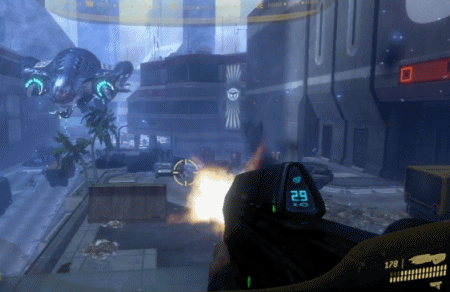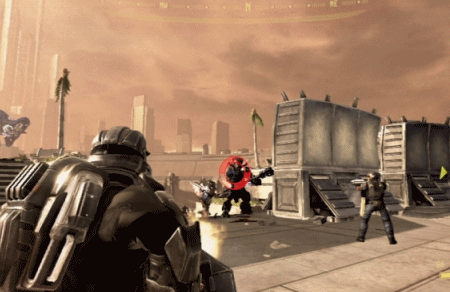 Review – Halo 3: ODST
Review – Halo 3: ODST

FPS
Six more hours of Halo 3.
![]()
Matthew
After merely playing a supporting role in the previous Halo games, the Orbital Drop Shock Troopers now have a game in their own right in which they take center stage in an attempt to show the Halo universe from a different point of view. Move over, Master Chief.
Taking place during the events of the first battle of Earth (as seen in Halo 2) the game begins moments before New Mombasa is heavily damaged by the Covenant invasion, and results in your squad ofODSTs being scattered across the city while dropping in from orbit. You take control of the Rookie who, after being knocked unconscious upon landing, wakes up ten hours after the incident and must piece together what has happened to his missing squad.

Still oddly low-res and ugly.
While previous games have been very linear, ODST shakes things up a little. When playing as the Rookie, you must explore the ruined streets of New Mombasa at night in what is a sandbox of sorts. It basically serves as a hub world for activating each level as you seek out beacons, ranging from a broken sniper rifle to a bashed helmet, to trigger the flashbacks in which you play as one of your missing comrades. More areas of the city are unlocked as you progress through the game. Scattered throughout the city are audio logs which tell the story of a citizen’s bid to escape the city during the invasion, and collecting these helps towards unlocking various supply points which contain valuable weapons and ammo, as well as a mongoose or two – very helpful for quickly travelling from one end of the city to the other. The Superintendent, the AI which watches over the city, has a clever and subtle method of helping in your search for the audio logs – car alarms and flashing signs will be triggered to guide you to the stop.
The whole flashback aspect works very well, and it’s interesting to see just how different parts of the city were a few hours earlier. Thegameplay throughout the flashback stays varied; from vehicle-exclusive missions, defending a post from an onslaught of Covenant and an escourt mission which, surprisingly, isn’t rubbish and irritating. It has it’s fair shair of set pieces, some of which will be very familiar if you have played previous Halo games, but that doesn’t stop them from losing their impact. It’s certainly not the hardest campaign and it stays relatively consistent, with no horrible difficulty spikes such as the awful Cortana level from Halo 3.
Of course, since you are playing as an ODST rather than Master Chief, you are much more vulnerable. Health packs make a return, and the new shield system is similar to that of the original Halo. Run into a group of Covenant all guns blazing and your health will be low in no time, indicated by the over-the-top grunting of the Rookie and the irritating beeping from his suit. As a result of this, using cover and making every shot count is a priority, especially on the higher difficulties. ODSTs are unable to dual-wield weapons, nor do they have a radar similar to that of Master Chief. However, one of the main advantages of playing as an ODST is their “VISR” helmet which highlights all enemies and friendlies, as well as dropped weapons and other important items – it also doubles as night vision which becomes invaluable in some areas, but it does make your chances of being spotted by the enemy much more likely. Grenade capacity has been increased from two to three, and two new weapons are introduced. First is the silencedSMG , and it’s probably my favourite weapon in the game. It’s reasonably powerful and effective against most enemies in the game, plus it’s a good sniping weapon due to the zoom capability. Speaking of sniping weapons, the new pistol is probably the best weapon for headshots , although most of this is due to the rather generous auto-aim. Overall, the weapon balance feels just right, with no standout, all-powerful boomstick.

...and too beige.
The vulnerability of the ODST, coupled with the dark, moody hub world provides what is certainly one of the most atmospheric experiences in a Halo game yet. It is often best to use stealth, rather than direct combat when you come across a group of the more powerful enemies in the game – particularly the Hunters, who seem more ruthless and powerful than ever. Creeping through the streets and spotting the green glow from a pair of Hunter’s weapons makes for some very tense moments. The same can be said for when a Phantom swoops in and unleashes a squad of Brutes to sweep through the area. Successfully sneaking around and taking them out one-by-one gives a great sense of satisfaction. The soundtrack, possibly the best in any Halo game yet, adds to the atmosphere. It fades in and out at just the right moments to help build suspense, and intensify firefights. Much like it’s predecessors, the soundtrack is definitely worth checking out.
|
Lurk Secondary Review ODST consists of 2 main parts, the single player game and the fire fight mode. I will talk first about the single player game. You play as “Rookie†who has to sneak about the city of New Mombasa. At certain points you switch back to playing another member of the ODST. Whilst playing as Rookie you will find sound files these are part of “Sadie’s Story†and these are the most interesting new thing about the game. Interesting how Bungie backed down on what this was originally going to be called which was Maddie’s Story. It is set before the invasion and is the story of a young girl who is trying to make her way into the city, to get a hold of the Superintendent. The Superintendent is a city wide computer that you can connect to, to help you find your way around the city as well as finding caches of weapons. Apart from the change in HUD to help you see enemies and weapons at night, the game pretty much plays like the original Halo. You have to pick up health packs, instead of the recharging shield from 2 and 3. Even the weapons seem to be a throwback to the original game. The pistol is very similar and you can’t dual wield weapons. The fire fight mode is a horde style game where you have to fight wave after wave of incoming enemies. Unlike horde in GOW2 you can ride around in vehicles and have a wide range of enemies that turn up. At the end of the day it seems to be de rigeur for FPS games to have this mode and whilst its a nice touch, its nothing overly special. Secondary Score: 7/10 |
Co-op with up to four players is once again possible in the campaign, but I’d highly recommend playing through it solo first. Particularly the sections as the Rookie, which are at their best as a solo experience, otherwise the atmosphere will be completely lost.
The new multiplayer mode, Firefight, is comparable to Horde in Gears of War 2. It plays pretty much the same, with you fighting off continuous waves of enemies on maps based on campaign levels, and points being awarded for kills. However, unlike Horde, there is no limit to the amount of stages and so it only ends once all players run out of lives. Skulls are also periodically activated to make things more challenging as you progress. This mode is a great addition to the game, but the lack of public matchmaking is baffling. You can only play private matches with friends and, while it is an inconvenience, playing with friends is always better than playing with randoms.
ODST also comes with a separate disc containing the Halo 3 multiplayer and all the maps to date, including the ones previously released as DLC, and the second part of the Mythic map pack containing three new maps – Longshore, Heretic and Citadel. While I prefer Call of Duty 4 and Battlefield: Bad Company online, the Halo 3 multiplayer is still as enjoyable as ever and the sheer variety of options means it is still going strong.
Despite starting off as an expansion pack, Halo 3: ODST more than merits its status as a full-priced retail release. The campaign weighs in at around six or seven hours on normal difficulty, but the different tactics needed on higher difficulty levels should add an hour or two onto that. Despite the lack of matchmaking, Firefight is a welcome addition to the game, and the presence of the Halo 3 multiplayer in its entirety only adds to the game’s worth. The complete absence of the Flood (one of the worst enemies in gaming) may well possibly mean this has the best singleplayer campaign of all the Halos. In what is possibly the last Halo game in this form, it is a fitting finale to the series which offers all the thrills and enjoyment that makes the series one of the best first-person shooters around.
8/10
Rating: 








 8/10
8/10
